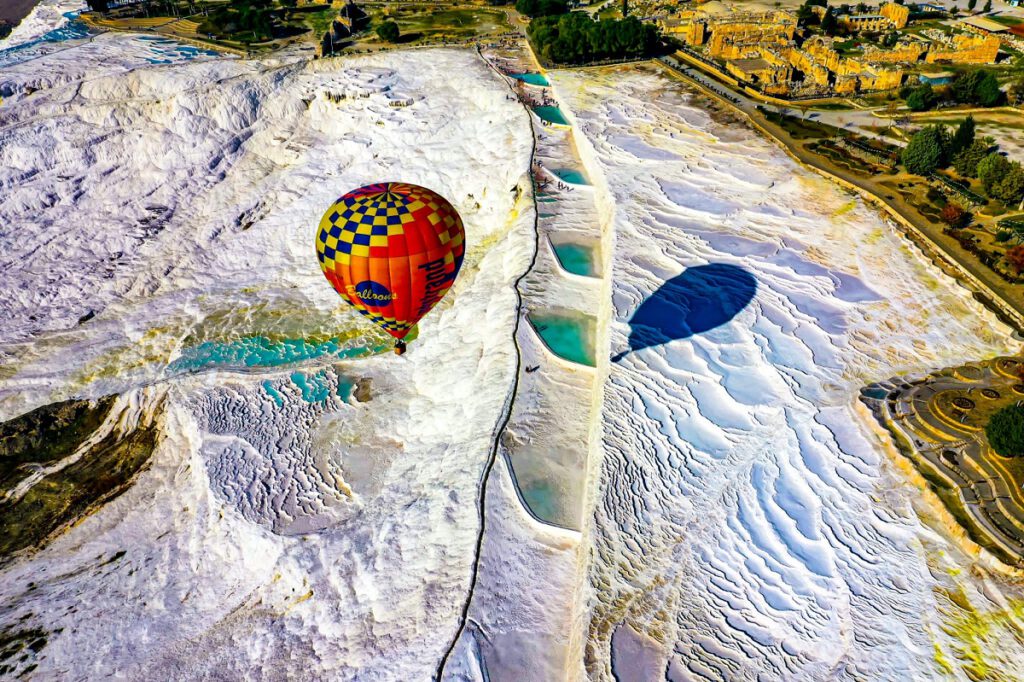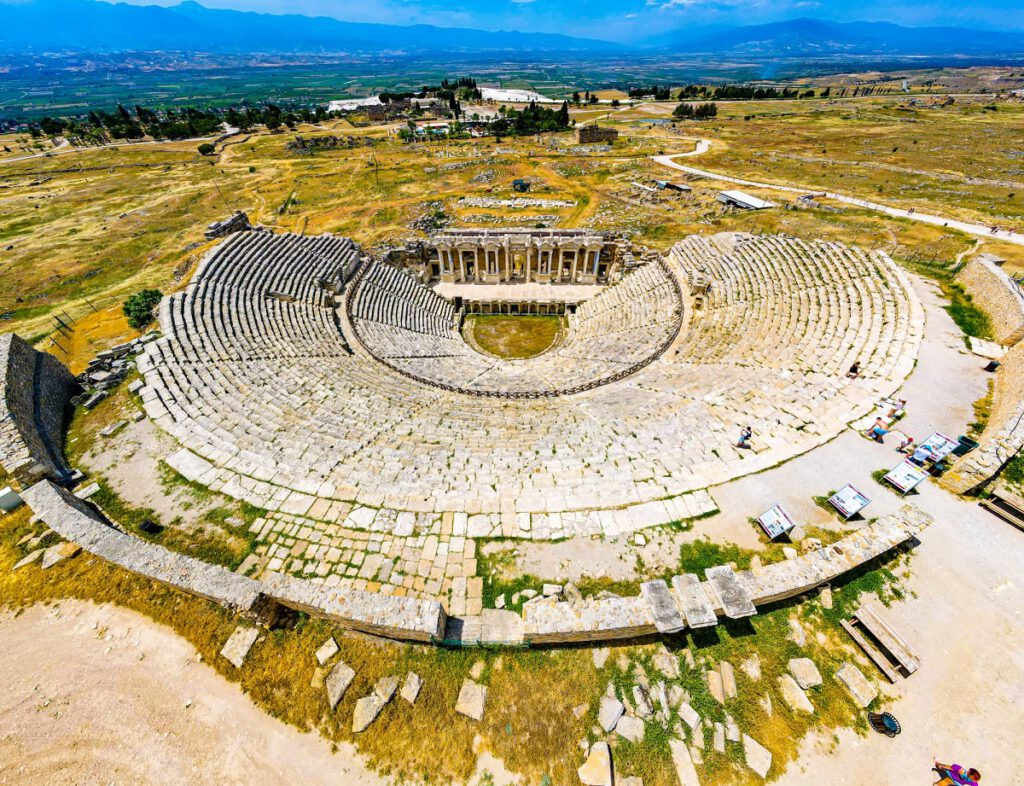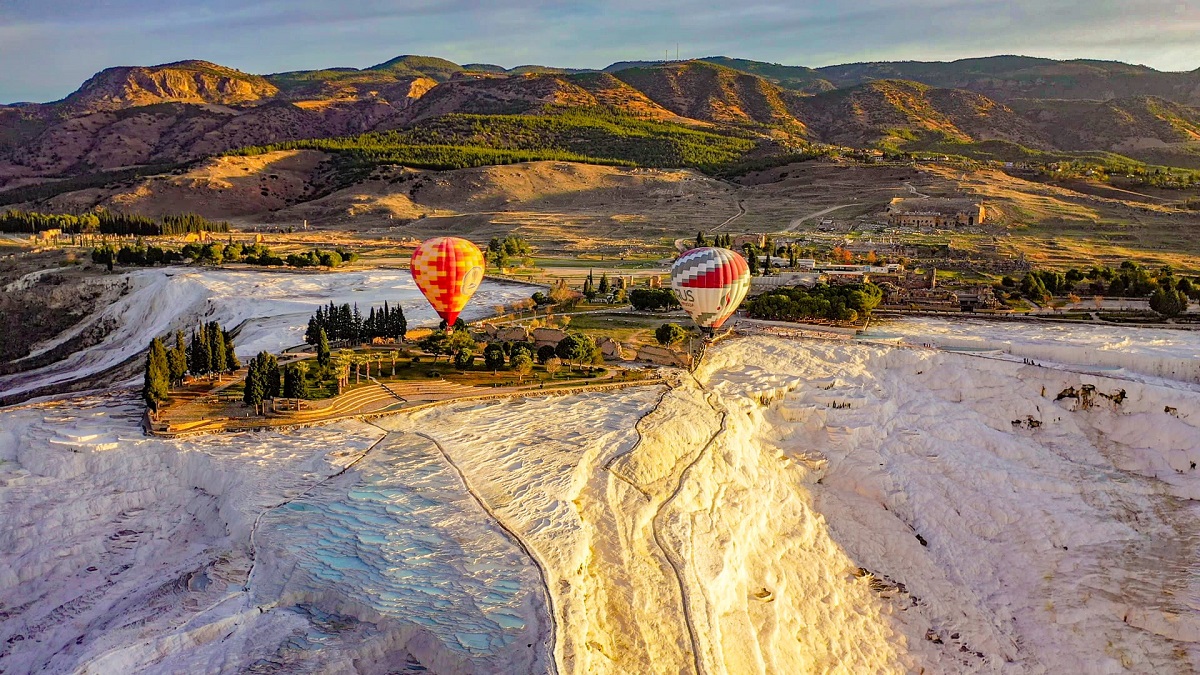Go to…
- General – About Pamukkale
- UNESCO – World Heritage Site – Travertines and Hierapolis
- Hot Springs – Limestone Travertines of Pamukkale
- Hierapolis – The Ancient City of Pamukkale
About this exceptional region
Pamukkale is the most populous and undoubtedly the most touristic district of Denizli province in the southwest of Turkey’s Aegean region. It is 20 km from Denizli, and various public vehicles depart from Denizli centre. Fares vary between 10 and 14 TL (2023 figures). Apart from that, you can rent a car and explore the surroundings yourself. The roads are smooth, easy to use and well-marked.
The number of 348 thousand people in the 2022 census has been increasing over the years. Due to its touristic nature, the region is constantly receiving immigration, albeit small.
In Pamukkale, which fascinates visitors at first sight, tourism officials aim to reach 3 million visitors in 2023. For this, meticulous work continues in the region.
Pamukkale – a must-see destination in Turkey
Pamukkale takes its name from the colour and form of the white travertines resembling frozen waterfalls. The soft white travertine stones begin to sediment due to the hot spring waters reacting with the air and precipitating after coming to the surface and hardening over time. These stones, which are white in Pamukkale, occur in different colours in the other 16 hot springs around it.
UNESCO World Heritage Sites – Travertines and Hierapolis
Pamukkale, which is on the list of places to see before you die, is known not only for its beauty. It is also for its healing and regenerative qualities. Cities were built, and kingdoms ruled in this region, which fascinated millions for thousands of years.
Today, it has managed to attract everyone interested in the history of humans like a magnet.
Pamukkale travertines are recognized as a World Heritage Site together with Hierapolis. Hierapolis-Pamukkale was inscribed on the UNESCO World Heritage List in 1988.
Relaxation and rejuvenation holiday in hot springs
The geography where Pamukkale is located, the Çürüksu (Lykos) Valley, has a unique structure with thermal water springs.
These springs range in temperature from 35°C to 100°C. Unlike those in Pamukkale, some of them are multi-coloured. Depending on the minerals and substances in the carbonic acid in the water, some springs have yellow, green, red, purple and brown travertines.
Pamukkale Hot Springs
It is believed to be the most prominent example of stepped travertine terraces in Pamukkale Hot Springs in the world. From a distance, it feels like snow has fallen on it.
Pamukkale is famous for its spring waters and terraced hills of travertine. These waters, which have been serving for thousands of years, have a temperature of 35.6° Celsius. These thermal waters have flowed for thousands of years in channels over 300 meters above and below ground before flowing into the travertines. In one section, the travertines are displayed as a series of platforms, each covered with milky blue water.
Following a doctor’s examination, these waters are recommended for treating cardiovascular stiffness, blood pressure, rheumatism and many other ailments according to the patient’s condition. It is also helpful for stomach spasms, diuresis and inflammation, kidney and sandstones.
The best way is to enter through the south gate and visit the region. But we must warn you: wearing shoes, sandals or slippers is forbidden while walking in the travertines; you must take off your shoes. The reason is the possible abrasion or staining of the soft calcite beds. Therefore, we recommend carrying a bag with you.

Karahayit Hot Springs (Red colored water)
Its waters contain small amounts of carbon dioxide and radioactivity. Known for its red water, Karahayıt’s water averages 50 degrees Celsius. Drinking cures are used to treat digestive system disorders, chronic inflammation of the gallbladder and bile ducts, obesity, diabetes and gout. It is also suitable for the circulatory system, heart, brain and vascular disorders, blood pressure and rheumatic syndromes.
Akköy Hot Springs
Akköy is located northwest of Pamukkale and west of Karahayıt. Healing mud baths are formed from the springs in Gölemezli village, one of its districts. Mud hot springs are mainly used in the treatment of skin diseases.
Tekkeköy Hot Springs
The healing waters of Tekkeköy Hot Springs, located in the south of Denizli, reaching 90 degrees Celsius, are suitable for respiratory diseases, skin diseases and rheumatism as a bath treatment. Drinking cures are ideal for the stomach, intestines, liver, gall bladder, and nutritional disorders.
Babacık (Kabaağaç) Hot Springs
Kaabaağaç Village is located 3 km from Tekke Village Greenhouse. It has a Roman bath, pool and changing areas. It offers healing to the problems of patients with different complaints ranging from rheumatism and joint disorders to skin diseases.
Kızıldere Hot Springs
The healing waters from the red rocks are used to treat respiratory, cardiovascular and rheumatic diseases. Located 11 km from Sarayköy, Kızıldere Hot Spring has two domed baths, two bathrooms, a pool and changing rooms. Kızıldere Hot Spring has 300-500 tons of hot water daily and is used for drinking and bathing.
Yenice Kamara Hot Springs
Yenice Kamara Hot Spring is located 25 km northeast of Pamukkale. The water temperature is 45 degrees and contains iron, copper, aluminium, calcium, magnesium, sulfate ions, sodium chloride and hydrocarbons. While the drinking water is good for diseases such as liver and biliary tract, stomach and ulcers, it is also suitable for rheumatism, sciatica, lumbago, haemorrhoids, neuritis, neuralgia, gynaecological disorders, arthritis, cardiovascular diseases and skin diseases such as hammam treatment.
There are many different accommodation options for those who want to spend all or part of their vacation in this direction. 4 – 5 star hotels, villas and private houses offer different possibilities. These accommodations are mainly located 5-25 km from Pamukkale, where the colourful travertines are also found.
If you have such an idea in mind, don’t forget to contact us!
Hierapolis – the stage of a civilization
Located in the heart of the Aegean, one of Turkey’s most historically and culturally rich regions, Hierapolis is a must-see masterpiece. Its name means Holy City in Latin.
Two thousand years ago, the Kingdom of Pergamum could not resist this attraction and built the city of Hierapolis next to the travertines. Even then, Hierapolis served as a thermal health centre, and its believed healing springs have been visited for thousands of years by people seeking health and beauty from different parts of Anatolia and the world.
The old city of Hierapolis was built right on top of the ‘Cotton Castle’, which is 2,700 meters long, 600 meters wide and 160 meters high.
It is estimated that the city’s population have been between 95,000-100,000, as the theatre capacity was 9,500 people.
The ancient city of Hierapolis has survived to the present day in a remarkably well-preserved state. Many artefacts were unearthed during excavations in Hierapolis and other nearby ancient sites, and some of the sculptures and other items are on display in the museum.
The parts of the ancient city that are the highlights: Hierapolis Theater, Great Bath Complex, Ancient Pool, Frontinus Street, Agora, North Byzantine Gate, South Byzantine Gate, Gymnasium, Triton Fountain Building, Ionic Colonnaded House, Latrina, Sanctuary of Apollo, Water Channels and Nympheums, Plutonium, Walls, Cathedral, St. Philippus Martrium, Nakrapoles.
Seeking a Cure for health and ultimate beauty
Hierapolis, a healing centre intertwined with religious rituals, was frequented by ancient people seeking a cure for their health problems. The three ancient baths, the ruins of which remain today, are the structures that have survived to the present day from this feature of the city. The Roman bath, one of the most frequented buildings of the ancient period, is now used as an archaeological museum. You will find the story of Pluto’s Gate (Plutonium), believed to be the Gate of Hell in Roman times, very fascinating.
These sections are so well preserved that you feel like you have travelled 2,000 years back in time.
The Opening hours (2023): South gate entrances are open between 06:30-20:00, and north gate entrances are open between 08:00-20:00
Box office closing time is 19:30
Entrance Fee:700 TL – An Audio Guidance Service is also available with an additional fee.
Hierapolis Theater
The Theater, which took 150 years to build, is one of the most beautiful examples of Roman theatres. This magnificent structure is divided into nine parts by eight staircases and has 50 rows in total.
In the friezes in the background of the theatre, there are many scenes: The birth of Apollo and Artemis, religious ritual scenes, entertainment scenes, music competition scenes, battles between gods and giants, kidnapping scenes, sporting competition scenes, and coronation ceremony.

Ancient Pool (Cleopatra Pool)
We don’t know if you’ve ever swam in a 23,000-year-old pool, but we haven’t before. Under Unesco’s protection, this pool was formed due to an earthquake in the 7th century AC. When the earthquake happened, a hole opened in the centre of this ancient city, and the beautiful columns of the town collapsed into this hole, and then the free thermal waters filled this hole. Thus, this ancient pool was formed. It is claimed that even Cleopatra, the Queen of Egypt, heard the praises of this pool. Since the thermal waters feed the pool, summer and winter temperatures are exactly 35.6° Celsius and PH 5.8. Imagine the pleasure of the pool in winter!
We should add a reminder: to swim in this breathtaking ancient pool, you must get a separate ticket.
Pamukkale Ancient Pool entrance fee is 130 TL for adults, 65 TL for children under 18 and free for children under 7. (May 2023). Prices are 50% discounted with the Museum card.
For a deposit of 20 TL, lockers can be rented, and the fee can be refunded when delivered.
There are showers and changing cabins. Pool usage time is a maximum of 2 hours. If you plan to enter the pool, do not forget to bring your swimsuit and underwater glasses / snorkel to see the historical ruins in the pool.
The Story of the Hell Gate (Plutonion)
Archaeologists discovered in 2011 that this door was still deadly; birds flying close to it suffocated and died. For this reason, the cave is considered in mythology to be the entrance to the hell of Pluto, ruler of the underworld. At the entrance to the Gate of Hell, called Plutonium, sacrificial ceremonies are organized. It is believed that the bulls sent through the gate during these ceremonies were sacrificed to Pluto because they died from the gas in the cave. Thus, the thermal water’s sacred power was shown to the guests coming to the ancient city.
Only later was the mystery scientifically solved. During the day, there was no danger as the sun’s heat dispersed the gases, but at night, they would rise and form a CO2 lake. One study showed that it is lethal enough to suffocate animals and even humans within a few minutes when the CO2 concentration reaches 35%, especially at dawn at 40 centimetres above the ground. However, this concentration drops rapidly with increasing altitude. When people do not stay long enough to keep their heads entirely out of the CO2 lake and dizziness sets in, their heads drop even lower, increasing CO2 absorption and leading to death by suffocation.

